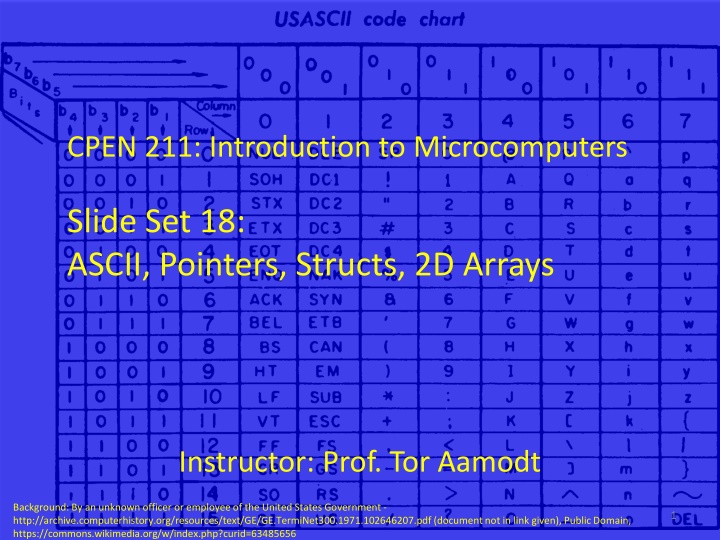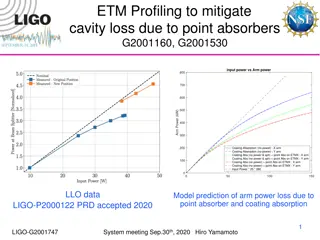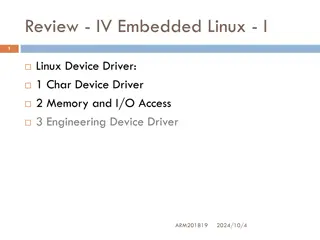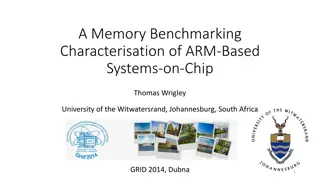
ASCII, UNICODE, and Emoji in Computer Communications
Delve into the realm of ASCII and UNICODE, exploring how letters and numbers are represented in computer systems. Learn about the evolution of UNICODE and its character encodings, including support for various languages like Chinese, Japanese, and Korean. Discover the integration of emojis in UTF-16 and the practical aspects of transferring characters within a computer system using bitwise operations.
Download Presentation

Please find below an Image/Link to download the presentation.
The content on the website is provided AS IS for your information and personal use only. It may not be sold, licensed, or shared on other websites without obtaining consent from the author. If you encounter any issues during the download, it is possible that the publisher has removed the file from their server.
You are allowed to download the files provided on this website for personal or commercial use, subject to the condition that they are used lawfully. All files are the property of their respective owners.
The content on the website is provided AS IS for your information and personal use only. It may not be sold, licensed, or shared on other websites without obtaining consent from the author.
E N D
Presentation Transcript
CPEN 211: Introduction to Microcomputers Slide Set 18: ASCII, Pointers, Structs, 2D Arrays Instructor: Prof. Tor Aamodt Background: By an unknown officer or employee of the United States Government - http://archive.computerhistory.org/resources/text/GE/GE.TermiNet300.1971.102646207.pdf (document not in link given), Public Domain, https://commons.wikimedia.org/w/index.php?curid=63485656 1
Learning Objectives After this slide set you should be able to: Write code that uses strings of human readable characters (and/or emoji s) Explain a simple performance optimization you can make by changing assembly code Write ARM code for programs that uses pointers and/or structs. 2
Communicating with People How are letters and numbers that you write on your computer represented? Two common representations: ASCII and UNICODE. Oldest is ASCII : American Standard Code for Information Interchange 8-bits per ASCII character UNICODE more recent (16-bits per character) 3 Text: COD4e 2.9
Printable ASCII Codes Hex ASCII Hex ASCII Hex ASCII Hex ASCII Hex ASCII Hex ASCII (space) 20 30 0 40 @ 50 P 60 ` 70 p 21 ! 31 1 41 A 51 Q 61 a 71 q 22 " 32 2 42 B 52 R 62 b 72 r 23 # 33 3 43 C 53 S 63 c 73 s 24 $ 34 4 44 D 54 T 64 d 74 t 25 % 35 5 45 E 55 U 65 e 75 u 26 & 36 6 46 F 56 V 66 f 76 v 27 ' 37 7 47 G 57 W 67 g 77 w 28 ( 38 8 48 H 58 X 68 h 78 x 29 ) 39 9 49 I 59 Y 69 i 79 y 2A * 3A : 4A J 5A Z 6A j 7A z 2B + 3B ; 4B K 5B [ 6B k 7B { 2C , 3C < 4C L 5C \ 6C l 7C | 2D - 3D = 4D M 5D ] 6D m 7D } 2E . 3E > 4E N 5E ^ 6E n 7E ~ 2F / 3F ? 4F O 5F _ 6F o 7F 4 Text: COD4e 2.9
UNICODE UNICODE was introduced in 1991, but it is an evolving standard. UNICODE includes characters for other languages such as Chinese, Japanese and Korean. 16-bits means UNICODE has 65536 encodings, but there is also a 32-bit variant of UNICODE (UTF-32) 5
Sample of Emoji in UTF-16 [ https://unicode.org/emoji/charts/emoji-list.html ] 6
Copying a Character We can move a single byte using LDR and STR but need to use bitwise logical operations. Suppose R0 is 100, and ASCII string starting at MEM[100] is Hello World! l e H l LDR R1,[R0,#0] // R1 = 6C6C6548 MOV R2,#255 // R2 = 000000FF AND R1,R1,R2 // R1 = 00000048 11111111 7 Text: COD4e 2.9
Copying a Character While we can using logical operations and LDR, working with ASCII characters is so common ARM has special load and store instructions for reading and writing a single byte. Suppose R0 is 100, R10 is 200 and ASCII string starting at MEM[100] is Hello World! Zero extend upper 24-bits LDRB R1,[R0,#0] // R1 = 00000048 STRB R1,[R10,#0] // MEM[200] = 48 8 Text: COD4e 2.9
Signed Load If read an 8-bit value from memory which represents a 2 s complement number we should sign extend the upper 24 bits. Suppose R0 is 100, and the byte value at MEM[100] is 0x80 Sign extend upper 24-bits LDRSB R1,[R0] // R1 = 0xFFFFFF80 9 Text: COD4e 2.9
Arrays versus Pointers Example: Write ARM assembly for the for loop in the following C code. Do not show instructions for saving and restoring registers on the stack. Assume R0 holds the base address of array and R1 holds size. clear1(int array[], int size) { int i; for (i = 0; i < size; i += 1) array[i] = 0; } 10 Text: COD4e 2.14
Array Version We will use R2 for i. First, we need to initialize i to zero: MOV R2,#0 // i = 0 We will use R3 to hold the value 0 we will write to memory (R2 will change each iteration): MOV R3,#0 // zero = 0 11 Text: COD4e 2.14
Array Version Use scaled register offset addressing mode to multiply i by 4 to get the byte address and then add it to the index to get the address of array[i]: loop1: STR R3, [R0,R2, LSL #2] // array[i] = 0 R0 + (R2 << 2) 12 Text: COD4e 2.14
Array Version Increment loop counter: ADD R2,R2,#1 // i = i + 1 Test if i < size: CMP R2,R1 // i < size BLT loop1 // if (i < size) go to loop1 13 Text: COD4e 2.14
Clearing Using Array indicies R0 holds array, R1 holds size: MOV R2,#0 // i = 0 MOV R3,#0 // zero = 0 loop1: STR R3, [R0,R2, LSL #2] // array[i] = 0 ADD R2,R2,#1 // i = i + 1 CMP R2,R1 // i < size BLT loop1 // if (i < size) go to loop1 14 Text: COD4e 2.14
Pointers TL;DR A pointer is a variable containing a memory address. It is like the base register in load/store instruction. That s it. C/C++ introduce syntax to expose to SW. <type name> * <pointer name>; &<variable name> *<pointer name> = <value> <variable name> = *<pointer name> <pointer name> -> <field name> // declare <pointer name> to be of type pointer to <type name> // returns address of <variable name> // dereference <pointer name> : write to memory // dereference <pointer name> : read memory // dereference field inside of struct/class Adding an integer N to a pointer of type pointer to <type name> changes value by N * sizeof(type name) 15 Text: COD4e 2.14
Arrays versus Pointers Example: Write ARM assembly for the for loop in the following C code. Do not show instructions for saving and restoring registers on the stack. Assume R0 holds the base address of array and R1 holds size. clear2(int *array, int size) { int *p; for (p = &array[0]; p < &array[size]; p = p + 1) *p = 0; } 16 Text: COD4e 2.14
Pointer Version We will use R2 to hold p and R3 to hold zero MOV R2,R0 // p = address of array[0] MOV R3,#0 // zero = 0 17 Text: COD4e 2.14
Post-indexed addressing STR R3,[R2],#4 // Memory[R2] = R3; R2 = R2 + 4 Specifies addressing mode is post-indexed . The above is equivalent to: STR R3,[R2] // Memory[R2] = R3 ADD R2,R2,#4 // R2 = R2 + 4 18 Text: COD4e 2.14
Pointer Version To write zero to memory use a store instruction. We can use ARM s immediate post-indexed addressing mode to increment p. loop2: STR R3,[R2],#4 // Memory[p] = 0; p = p + 4 Specifies addressing mode is post-indexed 19 Text: COD4e 2.14
We will use R4 to hold end address of array. We compute it using array + (size<<2) : ADD R4,R0,R1,LSL #2 // R4 = address of array[size] Then, loop test simply checks if p < end of array: CMP R2,R4 // p < &array[size] BLT loop2 // if (p<&array[size]) go to loop2 20 Text: COD4e 2.14
Clearing Array using Pointers Putting it all together: MOV R2,R0 // p = address of array[0] MOV R3,#0 // zero = 0 loop2: STR R3,[R2],#4 // Memory[p] = 0; p = p + 4 ADD R4,R0,R1,LSL #2 // R4 = address of array[size] CMP R2,R4 // p < &array[size] BLT loop2 // if (p<&array[size]) go to loop2 21 Text: COD4e 2.14
Optimization R4 (end of array) same each iteration means ADD can move outside of loop to make code faster (compiler can do this: gcc -O2 ): MOV R2,R0 // p = address of array[0] MOV R3,#0 // zero = 0 ADD R4,R0,R1,LSL #2 // R4 = address of array[size] loop2: STR R3,[R2],#4 // Memory[p] = 0; p = p + 4 CMP R2,R4 // p < &array[size] BLT loop2 // if (p<&array[size]) go to loop2 22 Text: COD4e 2.14
The Heap Most real programs create large data structures such as linked lists, trees, etc and they do this dynamically meaning the size varies while the program runs. These data structures placed in memory in a special region called the heap . Like the stack the heap can grow. 23 Text: COD4e 2.8
The Heap Stack grows down Heap grows up C allocates data from heap using malloc() and returns space using free() . Heap 24 Text: COD4e 2.8
C Structures and Linked Lists A common data structure for holding variable amounts of data is a linked list . For example, consider the C struct below. struct Node { int value; struct Node *pNext; }; 4 bytes 4 bytes The above C code declares a new type Node that contains one field named value of type int and another field pNext of type pointer to struct Node . 25
Example Program Returns address of memory allocated in heap struct Node *head = malloc(sizeof(struct Node)); struct Node *tail = malloc(sizeof(struct Node)); head->value = 10; head->pNext = tail; tail->value = 20; tail->pNext = NULL; 8 0x70008C00 0x70000000 head 10 20 0x70008C00 0x0 26
Write corresponding ARM assembly following two lines assume head is in R3, R4 contains 10 and R5 contains tail . head->value = 10; head->pNext = tail; Answer: STR R4,[R3,#0] STR R5,[R3,#4] 27
Two Dimensional (2D) Arrays How to write assembly code for following? float Array[N][N] = {{1,0,0},{0,1,0},{0,0,1}}; float sum=0.0; for(int i=0; i<N; i++) for(int j=0;j<N;j++) sum += Array[i][j]; #define N 3 28
2D to linear address mapping Array[i][j] is a function. Inputs i , j ; Output data value in Array for those inputs. Challenge: Memory is a one-dimensional (linear) map from address to data Need to convert i , j to address. Two approaches: Row or Column Major. AddrRow Major = base + (i*size(row) + j)*size(elem) AddrCol Major = base + (j*size(col) + i)*size(elem) C language specifies row major for 2D arrays. 29
Loading 2D Array in Memory 0.0 in IEEE single precision is 0x00000000 1.0 in IEEE single precision is 0 01111111 0000 000 = 0x3f800000 Array: .word 0x3f800000 .word 0 .word 0 .word 0 .word 0x3f800000 .word 0 .word 0 .word 0 .word 0x3f800000 First row of matrix Array is 1,0,0 Second row of matrix Array is 0,1,0 Third row of matrix Array is 0,0,1 Zero: .word 0 We ll use this for sum = 0.0; 30
ARMv7 Assembly Code LDR R0,=Zero FLDS S0,[R0] // S0 = 0.0 MOV R0, #0 // R0 is i MOV R2, #3 // R2 is N LDR R3,=Array // R3 is base of Array L1: MOV R1, #0 // R1 is j L2: MUL R4, R0, R2 // R4 = (i * size(row)) ADD R4, R4, R1 // R4 = (i * size(row)) + j MOV R4, R4, LSL#2 // R4 = ((i * size(row)) + j)*size(elem) ADD R4, R4, R3 // R4 = base + ((i * size(row)) + j)*size(elem) FLDS S1, [R4] // S1 = Array[i][j] FADDS S0, S0, S1 // sum += Array[i][j] ADD R1, R1, #1 // j++ CMP R1, R2 BLT L2 // while (j<N) ADD R0, R0, #1 // i++ CMP R0, R2 BLT L1 // while (i<N) We can convert for to do while since we can infer j<N is true first iteration of loop since we know j starts at 0 and we also know N is greater than 0. 31
Summary Learned about character encodings. Learned a little about performance optimization. Saw how pointers actually work, both with arrays and with structs. Saw how 2D arrays work at the assembly level. 32






















